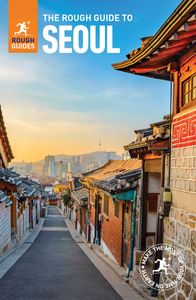Baengnyeongdo
Four hours’ ferry-ride from Incheon is BAENGNYEONGDO (백령도), almost tickling the North Korean coastline and as such home to many military installations. In 2010 the Cheonan, a South Korean naval vessel, suspiciously sank just off the island, seriously damaging relations between the two Koreas for details. Baengnyeongdo literally means “White Wing Island”, due to its apparent resemblance to an ibis taking flight, and although the reality is somewhat different you will find yourself gawping at Baengnyeongdo’s spectacular rock formations, best seen from one of the tour boats that regularly depart the port. Some of the most popular are off Dumujin, to the west of the island, while at Sagot Beach the stone cliffs plunge diagonally into the sea.
The tranquil nature of these islands is sometimes diluted by swarms of summer visitors – it’s best to visit on weekdays, or outside the warmest months. Ferries (3 daily) head to Baengnyeongdo from Incheon’s Yeonan pier, departing at 8am, 8.50am and 1pm; return sailings are at 8am, 1pm and 1.50pm. There’s also simple accommodation on Baengnyeongdo, though given the island’s distance from Incheon – and the recent military problems – it’s best to organize this at a tourist information office before heading out.
Deokjeokdo
Possibly the prettiest and most tranquil of the Yellow Sea isles, DEOKJEOKDO (덕적도) feels a world away from Seoul, though it’s quite possible to visit from the capital on a day-trip. There’s little in the way of sightseeing, and not much to do, but that’s just the point – the island has a couple of stunning beaches and some gorgeous mountain trails, and makes a refreshing break from the hustle and bustle of the mainland. Around the ferry berth are a few shops, restaurants and minbak, while a bus meets the ferries and makes its way round to Seopori Beach (서포리 해수욕장) on the other, quieter side of the island – also home to a few minbak. Most who stay here for a day or two spend their time chatting to locals, lazing or throwing back beers on the beach, going fishing or taking the easy climb up to the island’s main peak. Some adventurous souls make their way to Soyado (소야도), an island facing the ferry berth, and only a few minutes away if you can flag down a fishing boat. There’s even less to do than on Seongmodo, though there are a couple of motels and minbak if you look hard enough, and you can rest assured you’ll be one of very few foreigners to have overnighted on the island.
Ganghwado
Unlike most Yellow Sea islands, GANGHWADO (강화도) is close enough to the mainland to be connected by road – buses run regularly from Sinchon bus terminal in Seoul via Gimpo, taking around ninety minutes to arrive in Ganghwa-eup (강화읍), the ugly main settlement; from here local buses dash to destinations across the island, though the place is so small that journeys rarely take more than thirty minutes. While this accessibility means that Ganghwa lacks the beauty of some of its more distant cousins, there’s plenty to see. One look at a map should make clear the strategic importance of the island, which not only sits at the mouth of Seoul’s main river, the Han, but whose northern flank is within a frisbee throw of the North Korean border. Would-be adventurers should note that this area is chock-full of military installations, and closed to the public.
Before the latest conflict, this unfortunate isle saw battles with Mongol, Manchu, French, American and Japanese forces, among others. However, Ganghwado’s foremost sights date from further back than even the earliest of these fisticuffs – a clutch of dolmens scattered around the northern part of the island, dating from the first century BC and now on UNESCO’s World Heritage list.
Oepo
The small settlement of Oepo (외포; pronounced “Way-paw”) on the island’s western coast is by far the most appealing place to stay; small and delightfully old-fashioned, it’s a little like stepping into the Korea of the 1970s, before the country’s “economic miracle” mopped up old traditions by the bucketload. There are no particular sights, so wandering around to soak up the atmosphere is the order of the day. There’s an appealing little fish market near the dock, and restaurants all around it; you can even stay above one at the impossible-to-miss Santa Lucia (032/933 2141), the only building to take advantage of the village’s views of SEONGMODO (석모도), another island just across the water.
Ferries (every 30min; 10min) run to Seongmodo from Oepo’s tiny terminal, and ornithophobes should note that large flocks of seagulls tend to circumnavigate the vessel for the entire journey, waiting to catch thrown crisps (and highly proficient at doing so). Buses (15min) meet the ferries and head to Bomunsa (보문사), a charming temple that constitutes the island’s main sight. The complex is a five-minute uphill pant from the bus stop, with a small tearoom (9am–5pm) at its entrance; many choose to give their legs an extra workout by taking the mountain path behind the temple, which leads to a clutch of small grottoes that function as Buddhist shrines and boast wonderful sea views.
Ferries back to Ganghwado dry up at 8.30pm, but this is a wonderfully peaceful place to be stranded – there are restaurants and simple accommodation around both the temple and ferry terminal, as well as bicycle hire immediately off the ferry ramp for those with the muscle to pump up and down the island’s hilly roads.




















